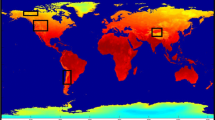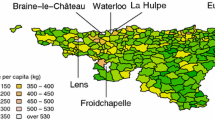Abstract
The detection of spatial outliers helps extract important and valuable information from large spatial datasets. Most of the existing work in outlier detection views the condition of being an outlier as a binary property. However, for many scenarios, it is more meaningful to assign a degree of being an outlier to each object. The temporal dimension should also be taken into consideration. In this paper, we formally introduce a new notion of spatial outliers. We discuss the spatiotemporal outlier detection problem, and we design a methodology to discover these outliers effectively. We introduce a new index called the fuzzy outlier index, FoI, which expresses the degree to which a spatial object belongs to a spatiotemporal neighbourhood. The proposed outlier detection method can be applied to phenomena evolving over time, such as moving objects, pedestrian modelling or credit card fraud.











Similar content being viewed by others
References
Adam NR, Janeja VP, Atluri V (2004) Neighborhood based detection of anomalies in high dimension spatio-temporal sensor datasets, 2004 ACM symposium on Applied Computing, March 14–17, Nicosia, Cyprus, P. 576–583
Anselin L (1995) Local Indicators of Spatial Association: LISA. Geogr Anal 27(2):93–115
Ball G, Hall D (1967) A clustering technique for summarizing multivariate data. Behav Sci 12:153–155
Bezdek JC (1981) Pattern recognition with fuzzy objective function algoritms. Plenum Press, New York
Barnett V, Lewis T (1994) Outliers in statistical data, John Wiley
Birant D, Kut A (2006) Spatio-temporal outlier detection in large databases. J Comput Inform Technol—CIT 14(4):291–297
Breunig M, Kriegel H, Ng RT, Sander J (1999) OPTICS-OF: identifying local outliers. In: Proc. of PKDD 99, Prague, Czech Republic, Lecture Notes in Computer Science (LNAI 1704), Springer Verlag, pp. 262–270
Breunig M, Kriegel H, Ng RT, Sander J (2000) LOF: identifying density-based local outliers. Proc. ACM SIGMOD 2000 Int. Conf. On Management of Data, Dalles, TX, 2000
Chen D, Chang Lu, Kou Y, Chen F (2008) On detecting spatial outliers. GeoInformatica 2008(12):455–475
Cheng T, Zhilin L, (2004) A multiscale approach to detect spatial-temporal outliers. Geo-Imagery Bridging Continents XXth ISPRS Congress, July 12–23, 2004, Istanbul, Turkey
Jensen A, Gavrilova M (2006) Normal vs abnormal behavior. Technical Report, SPARCS Lab, https://dspace.ucalgary.ca/bitstream/1880/45489/2/2006-819-12.pdf
Johnson R (1992) Applied multilevel statistical analysis. Prentice Hall
Knorr E, Ng R (1997) A unified notion of outliers: properties and computation. In Proc. Of the International Conference on Knowledge discovery and data mining, 219–222
Knorr E, Ng R (1998) Algorithms for mining distance based outliers in large datasets. In Proceedings of 24 th VLDB Conference, 1998
Lu Y, Thill J-C (2003) Assessing the cluster correspondence between paired point locations. Geographical Analysis, Vol 35, No 4. The Ohio State University
McNeill D, Freiberger P (1994) Fuzzy Logic—the revolutionary computer technology that is changing our world, Touchstone-Simon and Shuster, pp. 319
Ng R (2001) Detecting outliers from large datasets. In: Miller HJ, Han J (eds) Geographic data mining and knowledge discovery. Taylor and Francis, London, pp 218–235
Ramaswamy S, Rastogi R, Shim K (2000) Efficient algorithms for mining outliers from large data sets. In Proceedings of the 2000 ACM SIGMOD International Conference on Management of Data, pages 427–438
Ross JT (2004) Fuzzy logic with engineering applications. Wiley, England
Ruts I, Rousseeuw PJ (1996) Computing depth contours of bivariate point clouds. Comput Stat Data Anal 23(1):153–168
Shekhar S, Lu CT, Zhang P (2003) A unified approach to detection spatial outliers. GeoInformatica 7:139–166
Vaswani N, Chowdhury AR, Chellappa R (2003) Statistical shapetheory for activity modeling, International Conference on Multimedia and Expo, 2003. ICME’03 Proceedings, 2003, Volume 3, 6–9, July2003. Pg. 111-181-4 Vol. 3
Yamanishi K, Takeuchi J-I, Williams G, Milne P (2004) On-line unsupervised outlier detection using finite mixtures with discounting learning algorithms. Data Min Knowl Discov 8(3):275–300
Yamanishi K, Takeuchi J-I (2002) A unifying framework for detecting outliers and change points from non-stationary time series data, 10 Proceedings of the Eighth ACM SIGKDD International Conference on Knowledge Discovery and Data Mining, Pg. 676–681
Yu D, Sheikholeslami G, Zhang A (1999) Findout: finding outliers in very large datasets, In Development of Computer Science and Engineering, Tech Report 99–03, SUNY Buffalo
Zadeh LA (1965) Fuzzy sets. Inf Control 8:338–353
Zhang Y, Meratnia N, Havinga PJM (2008) Outlier detection techniques for wireless sensor networks: a survey. Technical Report TR-CTIT-08-59, Centre for Telematics and Information Technology, University of Twente, Enschede. ISSN 1381–3625
Zimmermann H-J (1993) Fuzzy technologien. Prinzipien, Werkzeuge, Potentiale. VDI-Verlag, Düsseldorf
Zhao J, Lu CT, Kou Y (2003) Detecting region outliers in meteorological data, Proceedings of the 11th International Symposium on Advances in Geographic Information Systems, New Orleans, Louisiana, pp. 49–55, Nov. 7–8
Author information
Authors and Affiliations
Corresponding author
Additional information
An erratum to this article can be found at http://dx.doi.org/10.1007/s10707-011-0150-7.
Rights and permissions
About this article
Cite this article
Grekousis, G., Fotis, Y.N. A fuzzy index for detecting spatiotemporal outliers. Geoinformatica 16, 597–619 (2012). https://doi.org/10.1007/s10707-011-0145-4
Received:
Revised:
Accepted:
Published:
Issue Date:
DOI: https://doi.org/10.1007/s10707-011-0145-4




